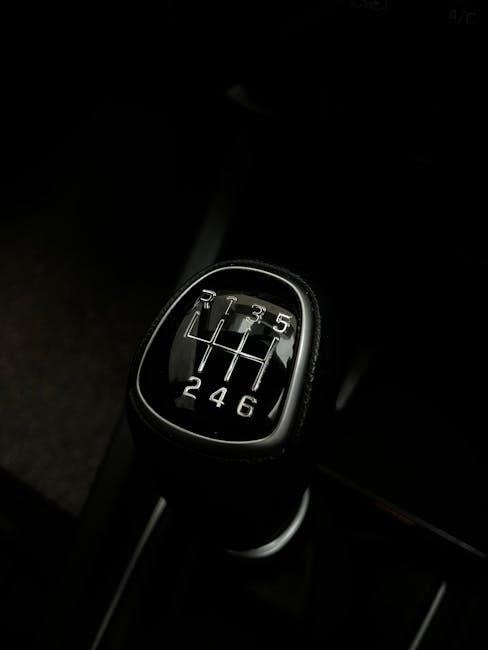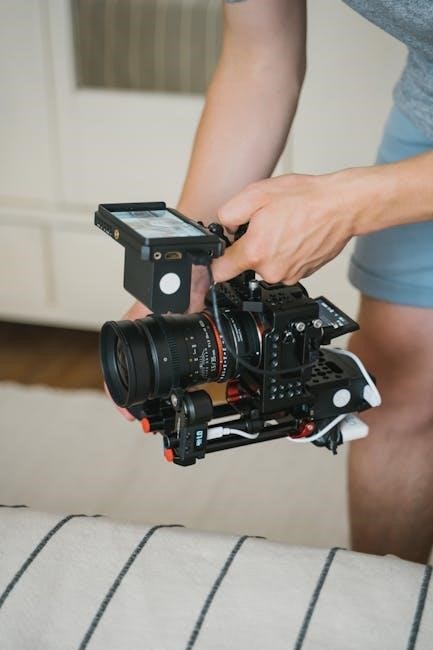manual transmission kicks out of gear
Manual transmissions kicking out of gear is a common issue‚ often caused by worn components or internal damage. This can lead to safety hazards and mechanical failure‚ making prompt diagnosis and repair crucial for maintaining drivetrain integrity and ensuring driver safety.
1.1 Overview of Manual Transmission Problems
Manual transmissions can experience issues like unexpectedly disengaging from gear‚ often due to worn mounts‚ loose linkages‚ or internal component failures. These problems can stem from aging parts‚ aggressive driving‚ or mechanical wear. Addressing these issues promptly is essential to prevent further damage and ensure safe operation. Regular maintenance and inspections are key to identifying and resolving these concerns before they escalate into costly repairs or complete system failure.
1.2 Importance of Addressing the Issue
Neglecting a manual transmission that kicks out of gear can lead to severe consequences‚ including complete transmission failure‚ costly repairs‚ and potential safety hazards while driving. Addressing the issue promptly ensures drivetrain reliability‚ prevents further damage to internal components‚ and maintains overall vehicle performance. Ignoring early symptoms can escalate minor repairs into major overhauls‚ emphasizing the need for timely intervention to safeguard both the vehicle and driver safety on the road.

Common Causes of Manual Transmission Kicking Out of Gear
Worn mounts‚ loose linkage‚ bad bearings‚ weak springs‚ or internal damage are common causes. These issues disrupt gear engagement‚ leading to unexpected disengagement while driving.
2.1 Worn Transmission Mounts
Worn transmission mounts allow excessive movement during acceleration‚ misaligning the shift linkage. This causes the transmission to disengage‚ especially when accelerating or decelerating. Over time‚ the mounts deteriorate‚ leading to inconsistent gear engagement. Replacing worn mounts can often resolve the issue‚ ensuring proper alignment and stability of the transmission.
2.2 Loose or Stretched Shift Linkage
Loose or stretched shift linkage disrupts the connection between the shifter and transmission‚ causing gears to disengage unexpectedly. Over time‚ rods or cables can wear out‚ creating excessive play. This misalignment prevents the transmission from staying securely in gear‚ especially during acceleration or shifting. Adjusting or replacing the linkage can restore proper gear engagement and eliminate the issue.
2.3 Bad Shifter Bearings
Bad shifter bearings can cause excessive play in the gear lever‚ making it difficult to maintain gear engagement. Worn bearings reduce precision‚ leading to gears slipping out unexpectedly. This issue often results from wear over time or improper installation. A loose shifter and grinding noises during shifts may indicate faulty bearings. Replacing the bearings is typically necessary to restore smooth‚ precise gear changes and prevent further transmission damage.
2.4 Weak or Broken Shift Rail Spring
A weak or broken shift rail spring is a common cause of manual transmissions popping out of gear. The spring is responsible for holding the gears securely in place. When it fails‚ the shifter can inadvertently move‚ disengaging the gear. This often occurs during acceleration or deceleration‚ leading to unexpected shifts into neutral. A broken spring requires immediate attention to prevent further damage to internal components. Replacing the spring or the entire shift rail assembly may be necessary to restore proper gear engagement and driver control.
2.5 Internal Transmission Failure
Internal transmission failure is a severe cause of manual transmissions kicking out of gear. Components like the shift fork assembly or synchronizer rings can wear out or break due to age or abuse. A bad synchronizer typically causes the transmission to slip out of specific gears‚ often during downshifting. Internal damage requires professional diagnosis and may necessitate a rebuild or replacement of the entire transmission. Ignoring these issues can lead to costly repairs and potential safety hazards‚ emphasizing the need for prompt action to ensure vehicle reliability and performance.

Symptoms of a Faulty Manual Transmission
Common symptoms include gears slipping out unexpectedly‚ difficulty engaging gears‚ and grinding or clunking noises during shifts. These issues signal potential internal or external component failures‚ requiring immediate attention to prevent further damage and ensure safe operation.
3.1 Gears Slipping Out Unexpectedly
Gears slipping out unexpectedly is a key symptom of a faulty manual transmission. This can occur during acceleration or deceleration‚ often due to worn components like synchronizers or shift forks. Such issues may also arise from a weak shift rail spring or damaged bearings‚ causing the gear to disengage involuntarily. This unpredictability can lead to loss of control‚ making it a critical indicator of underlying problems that require immediate attention to ensure safety and prevent further damage.
3.2 Difficulty Engaging Gears
Difficulty engaging gears is another common symptom of a faulty manual transmission. This can stem from worn synchronizers‚ damaged shift linkage‚ or low transmission fluid levels. When gears refuse to engage smoothly‚ it may indicate internal wear or alignment issues. Ignoring this problem can lead to further damage‚ such as stripped gears or a complete transmission failure. Addressing the root cause promptly is essential to restore proper shifting and maintain the transmission’s overall health.
3.3 Grinding or Clunking Noises
Grinding or clunking noises when shifting gears are indicative of mechanical issues within the transmission. These sounds often result from worn or damaged components such as synchronizers‚ bearings‚ or gear teeth. If left unchecked‚ these problems can escalate‚ leading to gear failure or complete transmission breakdown. Addressing these noises promptly is crucial to prevent further damage and ensure smooth operation of the manual transmission system.

Diagnostic Steps
Inspecting transmission mounts‚ shift linkage‚ and internal components helps identify issues. Testing gear engagement and listening for unusual noises are critical steps in diagnosing the problem accurately.
4.1 Inspecting Transmission Mounts
Inspecting transmission mounts involves checking for wear‚ cracks‚ or looseness. Worn mounts allow excessive movement‚ causing misalignment with the shifter linkage and potentially leading to gears disengaging. Mounts should be examined for proper securement and condition. If damaged‚ replacing them is essential to maintain transmission stability and prevent further issues. This step is crucial for ensuring the transmission remains firmly in place during operation.
4.2 Checking Shift Linkage for Play or Damage
Examine the shift linkage for any signs of wear‚ stretching‚ or damage. Loose connections or excessive play can cause the transmission to slip out of gear. Inspect rods‚ bushings‚ and joints for wear. If damage is found‚ replacement may be necessary. Proper linkage alignment ensures gears engage smoothly and remain secure during driving. Addressing linkage issues early prevents more severe mechanical problems and maintains transmission performance.
4.3 Examining the Shift Rail Spring
The shift rail spring is crucial for keeping gears securely engaged. Inspect the spring for weakness or breakage‚ as a faulty spring can cause the transmission to pop out of gear. Check if the spring holds the shifter firmly in place. If the spring is damaged or worn‚ replace it to restore proper gear engagement. A malfunctioning spring can lead to unexpected disengagement‚ posing a safety risk while driving; Regular inspection helps prevent such issues from arising.
4.4 Testing Internal Components
Internal components like the shift fork assembly‚ synchronizers‚ and gear teeth must be tested for wear or damage. If the transmission frequently slips out of gear‚ internal failure may be the cause. Inspect the synchronizer rings for smooth engagement and check gears for worn or chipped teeth. A damaged shift fork can prevent gears from locking properly. Testing these components requires specialized tools and expertise‚ often necessitating the removal of the transmission for a thorough inspection. Internal issues can be complex to diagnose but critical to address.

Repair and Adjustment Options
Repairs may involve adjusting the shift linkage‚ replacing worn mounts‚ or rebuilding internal components like the shift rail spring. Professional expertise is often required for internal fixes.
5.1 Adjusting the Shift Linkage
Adjusting the shift linkage involves tightening or replacing stretched or loose components. This ensures proper gear engagement and prevents slippage. Regular inspections and timely adjustments can prevent major issues‚ reducing the risk of the transmission disengaging unexpectedly while driving. Proper alignment and tension are critical for smooth operation and driver control‚ making this a key step in maintaining transmission reliability and performance over time.
5.2 Replacing Worn Transmission Mounts
Worn transmission mounts allow excessive movement‚ causing misalignment with the shift linkage and gears. Replacing these mounts stabilizes the transmission‚ ensuring proper gear engagement. This repair is cost-effective‚ typically ranging from $250 to $600‚ and prevents further damage to internal components. New mounts restore drivetrain stability‚ reducing the risk of the transmission popping out of gear during acceleration or shifting‚ thus enhancing overall vehicle performance and safety.
5.3 Rebuilding or Replacing the Shift Rail Spring
A weak or broken shift rail spring can cause the transmission to slip out of gear unexpectedly. Rebuilding or replacing this spring ensures gears remain securely locked. This repair is often more affordable than internal transmission overhauls‚ costing between $100 to $300 for parts and labor. A properly functioning spring restores reliable gear engagement‚ preventing unexpected shifts and enhancing driving safety. Regular inspection and timely replacement of this component are key to maintaining transmission performance and longevity.
5.4 Internal Transmission Repairs
Internal transmission repairs address serious issues like damaged synchronizers or shift forks‚ which can cause gears to slip out of place. These repairs often require disassembling the transmission‚ making them complex and labor-intensive. Costs typically range from $500 to $2‚000‚ depending on the extent of the damage. While rebuilding internal components can be costly‚ it’s essential for restoring proper gear engagement and ensuring long-term reliability. Professional expertise is usually necessary for these intricate fixes to avoid further complications and ensure durability.
Cost Estimates for Repairs
Repair costs vary widely‚ ranging from $250 for minor fixes like mounts to $5‚000 for full transmission replacements‚ depending on the vehicle’s make and model specifics.
6.1 Minor Repairs (Mounts‚ Linkage‚ etc.)
Minor repairs‚ such as replacing transmission mounts or adjusting shift linkages‚ are typically cost-effective. Mounts may cost between $50 to $150‚ while labor can add another $100 to $200. Replacing stretched or loose linkages might range from $100 to $300‚ depending on complexity. These fixes are often DIY-friendly‚ saving on labor costs‚ and can significantly improve gear engagement and stability. Early addressing of such issues prevents escalation to major repairs.
6.2 Major Repairs (Internal Components)
Major repairs involving internal components‚ such as shift forks or synchronizers‚ can be costly. Replacing a faulty synchronizer may cost between $300 to $700‚ while more extensive internal damage can range from $1‚000 to $2‚500. These repairs often require specialized tools and expertise‚ making them challenging for DIY enthusiasts. In severe cases‚ a full transmission rebuild or replacement‚ costing $1‚500 to $4‚000‚ may be necessary to restore proper function and reliability to the manual transmission system.
6.3 Transmission Replacement Costs
Replacing a manual transmission can range from $1‚000 to $5‚000‚ depending on the vehicle’s make and model. A rebuilt transmission is often more affordable than a brand-new one‚ with prices starting at around $1‚200. Labor costs typically add $500 to $1‚000‚ depending on the shop’s rates. In severe cases of internal damage‚ a full replacement is the only solution‚ ensuring long-term reliability and performance. Costs may vary based on location and the availability of parts.
Preventive Maintenance Tips
Regular inspection of mounts‚ linkage‚ and shift components helps detect wear early. Avoid aggressive driving and ensure proper lubrication of transmission parts to prevent premature failure.
7.1 Regular Inspection of Transmission Components
Regularly inspecting transmission mounts‚ shift linkage‚ and internal components is essential to identify wear or damage early. Check mounts for cracks or looseness‚ and linkage for play or stretching. Lubricate moving parts and ensure the shift rail spring is functioning properly. Addressing these issues promptly can prevent the transmission from kicking out of gear and avoid costly repairs down the line. Consistent maintenance ensures smooth operation and extends the lifespan of your manual transmission system.
7.2 Avoiding Aggressive Driving Habits
Avoiding aggressive driving habits‚ such as sudden acceleration or hard shifting‚ can significantly reduce wear on manual transmission components. Smooth‚ controlled driving minimizes stress on mounts‚ linkages‚ and internal gears. Avoid rapid downshifting or riding the clutch‚ as these actions can cause excessive strain. By adopting a calm and deliberate driving style‚ you can extend the lifespan of your transmission and prevent it from kicking out of gear due to premature component wear.
7.3 Lubricating Transmission Components
Regular lubrication of transmission components is essential for smooth operation. Use high-quality gearbox oil or transmission fluid to reduce friction and wear on gears and bearings. Proper lubrication prevents overheating and extends component lifespan. Check and replace the fluid as recommended by the manufacturer‚ typically every 30‚000 to 60‚000 miles. Using the correct lubricant ensures optimal performance and prevents premature wear‚ helping to avoid issues like gears slipping or the transmission kicking out of gear.
When to Seek Professional Help
Consult a professional if internal damage is suspected‚ such as grinding noises or frequent gear slippage‚ as DIY repairs may not address severe issues effectively.
8.1 Recognizing Internal Damage
Internal damage in a manual transmission can manifest as grinding noises‚ difficulty engaging gears‚ or frequent slippage. Such symptoms often indicate worn synchronizers‚ damaged gears‚ or a faulty shift fork. If the transmission consistently pops out of gear‚ it may signal a deeper issue like a broken shift rail spring or internal component failure‚ which requires professional intervention to diagnose and repair effectively.
8.2 Understanding DIY Limitations
While minor issues like adjusting shift linkages or replacing mounts can be DIY-friendly‚ internal transmission damage often requires professional expertise. Complex repairs‚ such as rebuilding synchronizers or replacing gears‚ demand specialized tools and knowledge. Attempting these without proper skills can lead to further damage or safety hazards. Recognizing these limitations is crucial to avoid worsening the problem and ensuring repairs are done safely and effectively by qualified mechanics.
Addressing manual transmission issues promptly is crucial for safety and preventing further damage. Regular maintenance and timely repairs ensure optimal performance and longevity of the drivetrain.
9.1 Summary of Key Points
Manual transmissions can slip out of gear due to worn mounts‚ loose linkages‚ or internal component failures. Regular inspections‚ avoiding aggressive driving‚ and proper lubrication help prevent issues. Addressing problems early ensures safety and prevents costly repairs. If unsure‚ consulting a professional is advisable to avoid further damage.
9.2 Final Recommendations
Regularly inspect transmission mounts‚ shift linkages‚ and internal components to prevent unexpected gear slippage. Address issues early to avoid costly repairs. Avoid aggressive driving habits and ensure proper lubrication of moving parts. If internal damage is suspected‚ consult a professional transmission specialist. Replacing worn or damaged components promptly can extend the lifespan of your manual transmission and ensure safe‚ reliable performance. Always follow manufacturer guidelines for maintenance and repairs.

Frequently Asked Questions
- Is it safe to drive with a manual transmission that kicks out of gear?
No‚ it is unsafe‚ as it can cause loss of control‚ especially during overtaking or in heavy traffic.
- Can I fix the issue myself?
Minor issues like adjusting the shift linkage or replacing mounts can be DIY‚ but internal damage often requires professional expertise.
- How can I prevent the problem from recurring?
Regular maintenance‚ avoiding aggressive driving‚ and replacing worn components promptly can help prevent the issue.
10.1 Is It Safe to Drive with a Manual Transmission That Kicks Out of Gear?
Driving with a manual transmission that kicks out of gear is unsafe‚ as it can cause unexpected loss of control‚ especially during overtaking or in heavy traffic. This issue increases the risk of accidents‚ making it crucial to address promptly. Avoid driving until repairs are made‚ as the problem may worsen over time‚ leading to further damage or complete transmission failure. Always prioritize professional inspection to ensure safety and prevent potential hazards on the road.
10.2 Can I Fix the Issue Myself?
Minor issues like adjusting shift linkage or replacing mounts can often be fixed by a DIY enthusiast with mechanical knowledge. However‚ internal transmission problems may require specialized tools and expertise‚ making professional assistance necessary. Assess your skill level and the severity of the issue before attempting repairs‚ as improper fixes can lead to further damage. Always consult a service manual for guidance‚ and consider seeking help from a transmission specialist if unsure.
10.3 How Can I Prevent the Problem from Recurring?
Regular maintenance is key to preventing manual transmission issues. Inspect transmission mounts‚ shift linkages‚ and springs for wear and tear. Lubricate internal components as recommended by the manufacturer. Avoid aggressive driving and sudden shifts to reduce stress on the transmission. Replace worn parts promptly and ensure proper alignment during repairs. Routine checks can help identify potential problems early‚ saving time and money in the long run and extending the lifespan of your manual transmission system.
